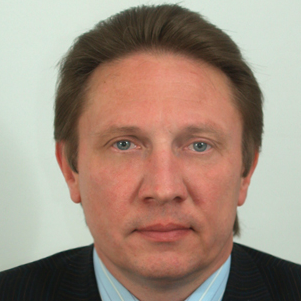
Viktor Kosenko
Work place: SE "Kharkіv Scientific-Research Institute of Mechanical Engineering Technology", Kharkiv, Ukraine
E-mail: kosvv@ukr.ua
Website:
Research Interests: Computer Science & Information Technology, Information Security, Information Systems, Information Retrieval, Information Storage Systems, Information Theory, Algorithmic Information Theory
Biography
Victor Kosenko was born in 1960. He graduated from Kharkov State University of Economics and got a degree in Industrial Management. In 2003 he defended his thesis for the degree of candidate of technical sciences, the specialty is "Automated control systems and innovative information technologies". From 2006 till 2010 he worked as the deputy director for scientific work at Kharkіv Scientific and Research Institute of Mechanical Engineering Technology, since 2010 he has held the post of the director of Kharkіv Scientific and Research Institute of Mechanical Engineering Technology. He is the author of more than one hundred scientific publications. He is a corresponding member of the Engineering Academy of Sciences of Ukraine. His scientific interests lie in the field of management systems and information technologies.
Author Articles
Criterion for Ranking Interval Alternatives in a Decision-Making Task
By Yuri Romanenkov Vadym Mukhin Viktor Kosenko Daniil Revenko Olena Lobach Natalia Kosenko Alla Yakovleva
DOI: https://doi.org/10.5815/ijmecs.2024.02.06, Pub. Date: 8 Apr. 2024
The study solves the problem of improving the methodological and algorithmic support of the decision-making process by developing a model of the preference criterion for interval evaluations of alternatives. The aim of the study is to improve the efficiency of decision-making based on interval expert data under conditions of uncertainty and risk by developing a criterion for the preferences of interval evaluations of overlapping alternatives. The object of the study is the decision-making process based on the classical efficiency matrix with interval elements, the subject is the model of decision maker's (DMP) preference criteria for interval evaluations of alternatives. The relevance of the task is stipulated by the urgency of the problem of adapting classical decision-making methods and models to practical problems of gray analysis, in particular, with interval uncertainty of primary expert data. A multifactorial model of the normalized preference criterion for interval evaluations of alternatives is proposed. Due to the additional consideration of the degree of preference of the DMP for the width of interval estimates, it allows ranking interval estimates of alternatives that overlap and are considered classically incomparable. A single analytical form of the normalized criterion model for ranking interval, weighted interval and point estimates makes it possible to increase the degree of automation of processing interval expert estimates in the decision-making process. Recommendations for the practical application of the proposed model are formulated. The developed model and corresponding algorithms can be used in automated expert decision support systems.
[...] Read more.The Method of Variant Synthesis of Information and Communication Network Structures on the Basis of the Graph and Set-Theoretical Models
By Vadym Mukhin Yury Romanenkov Julia Bilokin Anton Rohovyi Anna Kharazii Viktor Kosenko Nataliia Kosenko Jun Su
DOI: https://doi.org/10.5815/ijisa.2017.11.06, Pub. Date: 8 Nov. 2017
The subject matter of the article is developing information and communication network (ICN) for critical infrastructure systems (CIS). The aim of the work is to provide high-quality information and telecommunication processes by developing the optimal version of distributing CIS functional tasks and ICN processes to the network nodes. The article deals with following problems: developing a model for mapping the information and technical ICN structures, developing a method for variant synthesis of ITS structural models, a formalized representation of the problem of selecting CIS optimal structure. The methods used are: the system method, the set-theoretic and graphic analytic approaches, methods of hierarchic structures synthesis, optimization methods. The following results were obtained: the use of system approach for formalizing the information processing process in CIS was justified; mapping the ICS functional system into the information and technical one was presented as multilevel graph chain; the generalized representation of graph structures hierarchy was developed for the set of data transmitting tasks; this approach enabled formal representing alternative variants that consider the main links, sequencing, the amount and flows of the processed information among the different structure levels; the scheme of variant synthesis method of ICN models according to graph structures mapping was developed; the problem of selecting optimal ICN structures was formally presented; a complex efficiency criterion for solving problems of optimizing variant synthesis of structures; the problem of optimal synthesis of the structure of the given level factored in resource constraints was formulated. Conclusions. The article deals with such novelty aspects as improving the model of problem of selecting the optimal ICN structure by set-theoretic formalization factored in the criterion of maximum intensity of computational resource application, which enabled determining structural links among the major elements considering the decomposition of the model up to the basic elements such as "node" and "task" and the development of a new method of optimal ICN structuring which unlike the existing ones involves the variant synthesis of structures hierarchy and formalizing selection problems on the basis of set-theoretic models, which enables providing the efficiency of application of information and technical net resources.
[...] Read more.Other Articles
Subscribe to receive issue release notifications and newsletters from MECS Press journals